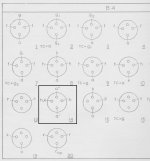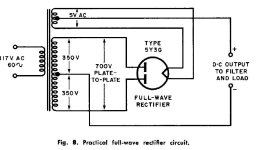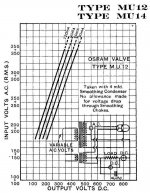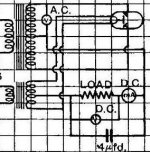Hi,
I have a hum problem with my tube rectifier that I would like you to share your experience with me, the story is as follow
I bought a MU12 mesh plate tube rectifier from ebay, the seller said the tube is strong (100ma) and balance.
In my preamp, I can use RGN1064, RGN1054, RGN2004 without any hum issue, I use CLCLC filter, the first capacitor is 2.16uf so I think it's not a problem with the rectifier tube.
Although MU12 is indirect rectifier (actually, it's called half direct as the cathode is connected to one end of the filament), however the pin arrangement is the same with other rectifier tube I'm using (using B4 tube socket) so I just plugged it in my preamp for a test.
To my surprise, I can hear hum which I think 50hz hum from my speaker if I stand around 1m from my speaker (which is around 87db sensitivity), if I change to my other rectifier tubes I heard no hum at all, so it puzzled me and I don't know why?
Do anyone of you have the same problem like me? is there anything I can do other than not using this tube which I think I like the tone of it
I have a hum problem with my tube rectifier that I would like you to share your experience with me, the story is as follow
I bought a MU12 mesh plate tube rectifier from ebay, the seller said the tube is strong (100ma) and balance.
In my preamp, I can use RGN1064, RGN1054, RGN2004 without any hum issue, I use CLCLC filter, the first capacitor is 2.16uf so I think it's not a problem with the rectifier tube.
Although MU12 is indirect rectifier (actually, it's called half direct as the cathode is connected to one end of the filament), however the pin arrangement is the same with other rectifier tube I'm using (using B4 tube socket) so I just plugged it in my preamp for a test.
To my surprise, I can hear hum which I think 50hz hum from my speaker if I stand around 1m from my speaker (which is around 87db sensitivity), if I change to my other rectifier tubes I heard no hum at all, so it puzzled me and I don't know why?
Do anyone of you have the same problem like me? is there anything I can do other than not using this tube which I think I like the tone of it
You have an oscilloscope?
With a 100× probe (get one if you don't have one), and a well insulated probe tip, you can safely poke around looking at your CLCLC filter in operation. The source of the hum will become visually apparent.
But for the folks here, you really need to include the SCHEMATIC of your amp including its power supply C, and L values. Just saying. Without it, we're “working in the dark”.
GoatGuy
(No? Why not!)
With a 100× probe (get one if you don't have one), and a well insulated probe tip, you can safely poke around looking at your CLCLC filter in operation. The source of the hum will become visually apparent.
But for the folks here, you really need to include the SCHEMATIC of your amp including its power supply C, and L values. Just saying. Without it, we're “working in the dark”.
GoatGuy
Although MU12 is indirect rectifier (actually, it's called half direct as the cathode is connected to one end of the filament), however the pin arrangement is the same with other rectifier tube I'm using (using B4 tube socket) so I just plugged it in my preamp for a test.
I thought the MU12 was a 'direct rectifier' and the filament is the cathode like the RGN10xx rectifiers. In which case it should not matter which end of the filament is used as the DC feed to the first capacitor.
But if as you say your MU12 is a sort of indirect type, you have to use the end of the filament connected to the cathode to feed the first capacitor. If you don't you will have the 4 volt ac supply superimposed on the DC output.
The UU5 is an equivalent with a cathode on pin 3, check the valve socket, and make sure pin 3 (not pin 4) is connected to the first capacitor.
The other difference is that the MU12 needs 2.5A at 4 volts, slightly more than the RGN10xx ones, is the filament transformer big enough? Failing that perhaps the valve is not so well balanced and you have a little half wave hum?
Alan
Attachments
Last edited:
just like this
datasheet:http://www.r-type.org/pdfs/mu12.pdf
datasheet:http://www.r-type.org/pdfs/mu12.pdf
Attachments
With a 'mesh plate' can some electrons reach 'escape velocity' and get out through the gaps?
Looks like they would, eh?
The lines of force terminate on the positive wires, so that's where they tend to go.
If they do slip through the fence, where would they go? The glass is neutral. There is a very strong tendency to turn-back and hit the attractive positive plate wires. 'From the other side' makes no difference at audio frequencies. (Electron transit time matters in radio work, and is key to some microwave tubes, but moot at 20KHz, more-moot in a power rectifier.)
Yes, I agree with you. I wonder why they use a ‘mesh plate’? Can’t see any advantage for heat dissipation.
It’s just speculation and a bit of fun, but I suppose an electron aimed for the middle of the hole would get through, as it would be equally attracted by every side of the hole.
There would be an ‘escape velocity’ where it can get away from the electric field of the anode, but since the force on the electron all came from the attraction towards the anode anyway, I guess that would be impossible to achieve.
Once an electron ‘got out’ I think it could pass through the glass (not sure about that) and could find itself attracted to a positively charged wire nearby ???
It’s just speculation and a bit of fun, but I suppose an electron aimed for the middle of the hole would get through, as it would be equally attracted by every side of the hole.
There would be an ‘escape velocity’ where it can get away from the electric field of the anode, but since the force on the electron all came from the attraction towards the anode anyway, I guess that would be impossible to achieve.
Once an electron ‘got out’ I think it could pass through the glass (not sure about that) and could find itself attracted to a positively charged wire nearby ???
...Once an electron ‘got out’ I think it could pass through the glass (not sure about that)... ???
Umm, no. (not at any sane voltage.)
Thank you all for your support and opinions. Unfortunately, I do not have an oscilloscope, so I could not make the measurements, however I have no hum when I use other rectifiers (RGN1064, RGN1054, RGN2004, U14) so I can rule out hum due to magnetic coupling from power transformer and chokes.
All in all, after some trials without success, I came to the conclusion that the hum is probably somehow due to the defective of the MU12 tube rectifier.
Thank Alan for the tip, I already tried to change the connection to the first cap to pin 3 (previously, I used pin 4) but there's no change in the humI thought the MU12 was a 'direct rectifier' and the filament is the cathode like the RGN10xx rectifiers. In which case it should not matter which end of the filament is used as the DC feed to the first capacitor.
But if as you say your MU12 is a sort of indirect type, you have to use the end of the filament connected to the cathode to feed the first capacitor. If you don't you will have the 4 volt ac supply superimposed on the DC output.
The UU5 is an equivalent with a cathode on pin 3, check the valve socket, and make sure pin 3 (not pin 4) is connected to the first capacitor.
The other difference is that the MU12 needs 2.5A at 4 volts, slightly more than the RGN10xx ones, is the filament transformer big enough? Failing that perhaps the valve is not so well balanced and you have a little half wave hum?
Alan
All in all, after some trials without success, I came to the conclusion that the hum is probably somehow due to the defective of the MU12 tube rectifier.
- Status
- This old topic is closed. If you want to reopen this topic, contact a moderator using the "Report Post" button.
- Home
- Amplifiers
- Tubes / Valves
- Hum from tube rectifier?



